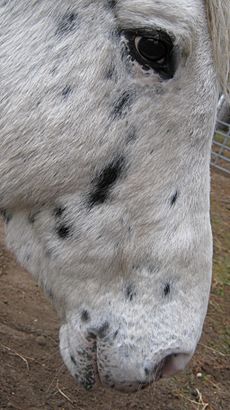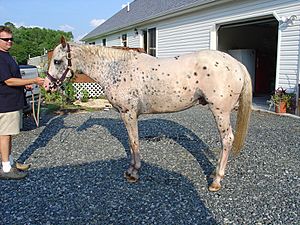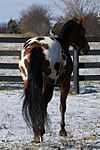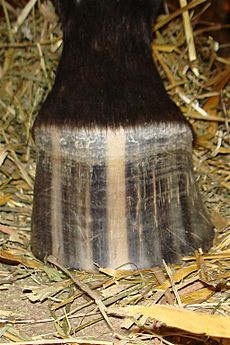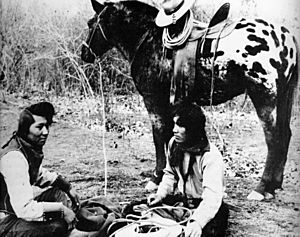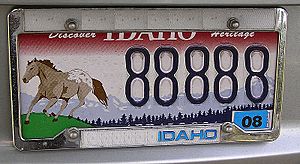Appaloosa facts for kids
The Appaloosa is a special American horse breed. It is famous for its unique, colorful spotted coat patterns. These horses come in many different body shapes. This is because many other horse breeds helped create the Appaloosa over time. Each Appaloosa's color pattern comes from different spotting genes. These genes are laid over one of several basic coat colors. The Appaloosa's color is interesting to scientists who study equine coat color genetics. This is because its spots and other features are linked to a special gene change called the leopard complex mutation (LP). Appaloosas can sometimes get certain eye problems. These include equine recurrent uveitis and night blindness. The night blindness is linked to the leopard complex gene.
Ancient cave paintings in Europe show horses with leopard spots. Pictures of tamed horses with spotted patterns appeared in art from Ancient Greece and Han dynasty China. Later, they were seen in art from the early modern period. In North America, the Nez Perce people developed the first American Appaloosa breed. They lived in what is now the United States Pacific Northwest. Early settlers called these spotted horses "Palouse horses." This name might have come from the Palouse River. This river flowed through the heart of Nez Perce land. Over time, the name changed to Appaloosa.
The Nez Perce people lost most of their horses after the Nez Perce War in 1877. The Appaloosa breed then became very rare for many years. A small group of dedicated breeders worked hard to save the Appaloosa. The Appaloosa Horse Club (ApHC) was formed in 1938 to keep track of the breed. Today, the modern Appaloosa still has family lines from the first horses registered. The club allows some Thoroughbred, American Quarter Horse, and Arabian horses to be added to the breed.
Today, the Appaloosa is one of the most popular horse breeds in the United States. It became the official state horse of Idaho in 1975. Appaloosas are well-known as stock horses. They are used in many western riding sports. But they are also very flexible horses. You can see them in many other types of horse activities. Appaloosas have been in many movies. An Appaloosa is also the mascot for the Florida State Seminoles. Appaloosa horses have also influenced other breeds. These include the Pony of the Americas, the Nez Perce Horse, and several gaited horse breeds.
Contents
What Makes an Appaloosa Special?
The Appaloosa is most famous for its special, spotted coat. This coat is called the leopard complex pattern. It is the most desired look for the breed. The spots appear in different patterns over one of several basic coat colors. Appaloosas also have three other main features. These are mottled skin, striped hooves, and eyes with a white sclera.
Mottled skin usually shows up around the nose, eyes, and private areas. Striped hooves are a common trait. They are very easy to see on Appaloosas. But other breeds can have them too. The sclera is the white part of the eye around the iris. All horses show white around their eyes if they roll their eyes back. But Appaloosas often have a white sclera that is easy to see even when their eye is normal. Sometimes, an Appaloosa is born with few or no visible spots. The ApHC still allows these horses to be registered. They must have mottled skin and at least one other main feature. Horses with two Appaloosa parents but no clear Appaloosa features are called "non-characteristic." They have a special, limited registration.
Appaloosas come in many different body types. This is partly because their spotted coat is their main identifying feature. Also, many different horse breeds helped create them. Their weight can range from 950 to 1250 pounds (430 to 570 kg). Their height is usually between 14 and 16 hands. However, the ApHC does not allow pony or draft horse breeding.
The first "old type" Appaloosa was a tall, lean horse. Its body shape came from a mix of horses. This started with traditional Spanish horses already in America before 1700. Then, European horses from the 1700s were added. These included "pied" (spotted) horses that were popular then. They were sent to the Americas when their color went out of style in Europe. These horses were similar to a tall, slim Thoroughbred-Andalusian type. The original Appaloosa often had a curved face. This looked like the warmblood-Jennet crosses from the 1500s.
Later, draft horse blood was added to the old-type Appaloosa. This happened after the Nez Perce were defeated in 1877. The U.S. Government made Native Americans become farmers. They gave them draft horse mares to breed with their existing stallions. Early Appaloosas often had thin manes and tails. But this was not a main feature. Many early Appaloosas had full manes and tails. There might be a link between the leopard complex gene and thin manes and tails. But scientists do not fully understand this link yet.
After the Appaloosa Horse Club started in 1938, a more modern type of horse was developed. This happened by adding American Quarter Horse and Arabian bloodlines. Adding Quarter Horse lines made Appaloosas better at sprint racing and halter shows. Many cutting and reining horses came from crossing old-type Appaloosas with Arabian horses. A famous example is the Appaloosa foundation stallion Red Eagle. In the 1970s, Thoroughbred blood was added. This made horses better suited for racing. Many breeders today also try to avoid the thin "rat tail" trait. So, modern Appaloosas usually have fuller manes and tails.
Appaloosa Colors and Patterns
An Appaloosa's coat color is a mix of a base color and a spotted pattern on top. The Appaloosa Horse Club recognizes several base colors. These include bay, black, chestnut, palomino, buckskin, cremello or perlino, roan, gray, dun, and grulla. The spots are usually over darker skin. They often have a "halo" effect. This means the skin next to the spot is dark, but the hair over it is white.
It is not always easy to guess an Appaloosa's color when it is born. Foals of any breed often have coats that get darker when they lose their baby hair. Also, Appaloosa foals do not always show clear leopard complex features right away. Their patterns can change as they grow older. But some patterns, like the blanket and leopard patterns, usually stay the same. Horses with varnish roan and snowflake patterns often show very little color when born. They develop more visible spots as they get older.
The ApHC also recognizes "solid" horses. These horses have a base color but no spotted Appaloosa pattern. Solid horses can still be registered if they have mottled skin and at least one other leopard complex feature.
The base colors are covered by different spotting patterns. These patterns can vary a lot and do not always fit perfectly into one group. Here are some common patterns:
How Appaloosa Colors Work (Genetics)
Any horse that shows Appaloosa features like coat pattern, mottled skin, striped hooves, and a white sclera has at least one copy of the dominant "leopard complex" (LP) gene. The word "complex" is used because this gene can create many different patterns. The LP gene is a special mutation in the TRPM1 gene on horse chromosome 1 (ECA 1). All horses with at least one copy of LP show leopard features. Horses that have one copy of LP (called heterozygous) tend to be darker than horses with two copies (called homozygous). But this is not always true.
Scientists have found three small changes in the TRPM1 gene. These changes are strongly linked to the LP mutation. But how the pattern is made is still not fully clear. Soon, there will likely be a DNA test available. Breeders can use this test to see if a horse has the LP gene, even if it does not show clear Appaloosa features.
Not every Appaloosa has visible spots. But even solid-colored horses that carry at least one dominant LP gene will show other features. These include vertically striped hooves, white sclera in the eye, and mottled skin around the eyes, lips, and private areas. Appaloosas can also have sabino or pinto markings. However, pinto genes can hide Appaloosa patterns. Because of this, the ApHC discourages pinto breeding. They will not register horses with too many white markings. The genes that create these different patterns can all be in the same horse. The Appaloosa Project, a group that studies genetics, has looked into how Appaloosa and pinto genes interact.
Appaloosa History
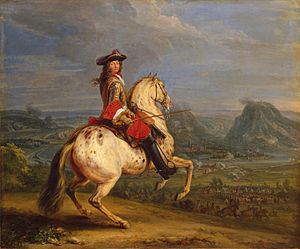
New research suggests that ancient cave paintings in Europe might have shown real wild horses with leopard spots. Tamed horses with leopard complex spots have been seen in art for a very long time. This includes art from Ancient Greece, Ancient Persia, and the Han Dynasty in China. Later, pictures appeared in France in the 1500s and 1600s. These paintings showed spotted horses used for riding. Other records show they were also used as coach horses for King Louis XIV of France. In the mid-1700s in Europe, spotted horses were very popular with kings and queens. These horses were used in riding schools, for parades, and other fancy events. Today, European breeds like the Knabstrupper and the Noriker horse still have leopard complex spotting.
The Spanish likely got spotted horses through trade with southern Austria and Hungary. The color pattern was known there. Spanish explorers and settlers then brought some brightly marked horses to the Americas in the early 1500s. One horse with snowflake spots was listed among the 16 horses Cortez brought to Mexico. Other spotted horses were mentioned by Spanish writers by 1604. More arrived in the Americas when spotted horses went out of style in Europe in the late 1700s. They were shipped to Mexico, California, and Oregon.
The Nez Perce People and Their Horses
The Nez Perce people lived in what is now eastern Washington, Oregon, and north central Idaho. They were good at farming and also at horse breeding. The Nez Perce first got horses from the Shoshone people around 1730. They lived in a great area for raising horses. It was also safe from other tribes' raids. They started strict breeding rules for their animals by 1750. They were one of the few tribes that would geld (neuter) male horses that were not good for breeding. They also traded away poorer horses. This helped them remove unsuitable animals from their breeding group. Because of this, they were known as excellent horse breeders by the early 1800s.
The early Nez Perce horses were thought to be very good quality. Meriwether Lewis of the Lewis and Clark Expedition wrote in his journal in 1806: "Their horses appear to be of an excellent race; they are lofty, eligantly formed, active and durable: in short many of them look like fine English coarsers and would make a figure in any country." Lewis did notice spotted patterns. He said, "... some of these horses are pided [pied] with large spots of white irregularly scattered and intermixed with the black brown bey or some other dark colour." By "pied," Lewis might have meant the leopard-spotted patterns seen in today's Appaloosa. But Lewis also noted that "much the larger portion are of a uniform colour." The Appaloosa Horse Club believes that only about ten percent of the horses owned by the Nez Perce at that time were spotted. The Nez Perce originally had many solid-colored horses. They only started to focus on color in their breeding after Lewis and Clark visited. By the late 1800s, they had many spotted horses. As white settlers moved onto Nez Perce lands, the Nez Perce became rich from trading horses. In 1861, their horses were described as "elegant chargers, fit to mount a prince." At a time when regular horses cost $15, non-Indians who bought Appaloosas from the Nez Perce turned down offers of up to $600.
The Nez Perce War and Its Impact
The Nez Perce had been at peace with the United States since an agreement made by Lewis and Clark. But gold miners in the 1860s and settlers in the 1870s put pressure on the Nez Perce. A treaty in 1855 allowed them to keep most of their land. But another treaty in 1863 cut their land by 90 percent. The Nez Perce who refused to give up their land under the 1863 treaty included a group led by Chief Joseph. They lived in the Wallowa Valley of Oregon. Tensions grew, and in May 1877, General Oliver Otis Howard ordered the non-treaty groups to move to a reservation. Chief Joseph thought fighting the army was useless. By June 14, 1877, he had gathered about 600 people near what is now Grangeville, Idaho. But on that day, a small group of warriors attacked nearby white settlers. This led to the Nez Perce War.
After some small battles in Idaho, more than 800 Nez Perce people, mostly not warriors, took 2000 animals, including horses. They fled into Montana. Then they traveled southeast, going into Yellowstone National Park. A small number of Nez Perce fighters, fewer than 200, successfully fought off larger U.S. Army forces in several fights. This included the two-day Battle of the Big Hole in Montana. They then moved northeast, trying to find safety with the Crow Nation. When the Crow refused, they headed for safety in Canada.
During this journey of about 1400 miles (2300 km), the Nez Perce relied heavily on their fast, agile, and tough Appaloosa horses. The journey ended when they stopped to rest near the Bears Paw Mountains in Montana. This was 40 miles (64 km) from the Canada-US border. The Nez Perce did not know that Colonel Nelson A. Miles had led an army group in pursuit. On October 5, 1877, after a five-day fight, Chief Joseph surrendered. The battle and the war were over. Most of the war chiefs were dead, and the non-fighters were cold and starving. Joseph said he would "fight no more forever."
After the War
When the U.S. 7th Cavalry accepted Chief Joseph's surrender, they immediately took more than 1,000 of the tribe's horses. They sold what they could and shot many of the rest. But many horses had been left behind in the Wallowa valley when the Nez Perce started their retreat. More horses escaped or were left behind along the way. The Nez Perce were eventually settled on reservation lands in north central Idaho. They were allowed to have few horses. The Army also made them crossbreed their horses with draft horses to create farm horses. The Nez Perce tribe never became famous horse breeders again. In the late 1900s, they started a program to create a new horse breed, the Nez Perce Horse. They wanted to bring back their horse culture and tradition of careful breeding.
Even though some Appaloosa horses remained after 1877, they were almost forgotten as a special breed for nearly 60 years. A few good horses continued to be bred. These were mostly horses captured or bought by settlers and used as working ranch horses. Others were used in circuses and shows, like Buffalo Bill's Wild West Show. Settlers first called the horses "Palouse horses." This was a reference to the Palouse River that ran through the old Nez Perce land. Slowly, the name changed to "Apalouse," and then "Appaloosa." Other early names included "Appalucy," "Apalousey," and "Appaloosie." By the 1950s, "Appaloosa" was the correct spelling.
Bringing the Appaloosa Back
The Appaloosa became known to the public in January 1937. This happened when Francis D. Haines, a history professor from Lewiston, Idaho, wrote an article in Western Horseman magazine. He described the breed's history and asked people to help save it. Haines had done a lot of research. He traveled with a friend, George Hatley, who loved Appaloosas. They visited many Nez Perce villages, gathered history, and took pictures. The article created a lot of interest in the breed. This led to the founding of the Appaloosa Horse Club (ApHC) in 1938. Claude Thompson and a small group of other breeders started it. The club was first in Moro, Oregon. But in 1947, the group moved to Moscow, Idaho, led by George Hatley. The Appaloosa Museum foundation was started in 1975 to keep the history of the Appaloosa horse alive. The Western Horseman magazine, especially its longtime publisher, Dick Spencer, continued to support the breed with many articles.
A big influence used to bring the Appaloosa back was the Arabian horse. Early registration lists show that Arabian-Appaloosa crosses were ten of the first fifteen horses registered with the ApHC. For example, one of Claude Thompson's main breeding stallions was Ferras. Ferras was an Arabian stallion bred by W.K. Kellogg. He came from horses imported from England's Crabbet Arabian Stud. Ferras had a son named Red Eagle, a famous Appaloosa stallion. He was added to the Appaloosa Hall of Fame in 1988. Later, Thoroughbred and Quarter Horse lines were added. Crosses from other breeds, like Morgans and Standardbreds, were also used. In 1983, the ApHC limited the number of outside breeds allowed. Only Arabian horses, American Quarter Horses, and Thoroughbreds were approved.
By 1978, the ApHC was the third largest horse registry for light horse breeds. From 1938 to 2007, over 670,000 Appaloosas were registered by the ApHC. The state of Idaho made the Appaloosa its official state horse on March 25, 1975. Idaho Governor Cecil Andrus signed the law. Idaho also offers a special license plate with an Appaloosa on it. It was the first state to offer a plate with a state horse.
How to Register an Appaloosa
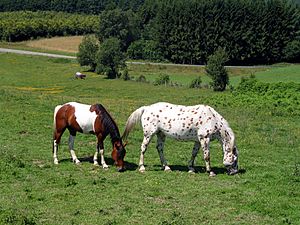
The ApHC is located in Moscow, Idaho. It is the main group that promotes and protects the Appaloosa breed. It is an international organization. There are Appaloosa groups in many South American and European countries. Also in South Africa, Australia, New Zealand, Canada, Mexico, and Israel. The American Appaloosa Association was started in 1983. Its members did not agree with registering plain-colored horses. This was due to a disagreement about the color rules. This group is based in Missouri and had over 2,000 members in 2008. Other "Appaloosa" registries have been started for horses with leopard complex genes. But these are not connected to the ApHC. These registries often have different founding horses and histories than the North American Appaloosa. The ApHC is by far the largest Appaloosa horse registry. It also hosts one of the world's biggest horse shows.
The Appaloosa is "a breed defined by ApHC family line rules and desired features, including coat pattern." This means the Appaloosa is a special breed from certain family lines. It has clear physical traits and a desired color. Appaloosas are not just a "color breed." All ApHC-registered Appaloosas must have two registered Appaloosa parents. Or, they can have one registered Appaloosa parent and one parent from an approved breed. Approved breeds include Arabian horses, Quarter Horses, and Thoroughbreds. In all cases, one parent must always be a regularly registered Appaloosa. The only exception to these rules is for Appaloosa-colored geldings (male horses that cannot breed) or spayed mares (female horses that cannot breed) with unknown family trees. Owners can apply for "hardship registration" for these horses that cannot breed. The ApHC does not accept horses with draft, pony, Pinto, or Paint breeding. Appaloosas must be at least 14 hands tall when grown, without shoes. If a horse has too many white markings that are not part of the Appaloosa pattern (like those of a pinto), it cannot be registered. This is unless DNA tests prove both parents are ApHC registered.
Other features are used to decide if a horse gets "regular" registration. These include striped hooves, a white sclera visible when the eye is normal, and mottled (spotted) skin around the eyes, lips, and private areas. The Appaloosa is one of the few horse breeds to show mottled skin. This feature "...is a very basic and clear sign of an Appaloosa." Appaloosas born with a visible coat pattern, or mottled skin and at least one other feature, are registered with "regular" papers. They have full rights to show and breed. A horse that meets the family line rules but is born without the recognized color pattern and features can still be registered with the ApHC. These are called "non-characteristic" Appaloosas. These solid-colored, "non-characteristic" Appaloosas cannot be shown at ApHC events. This is unless the owner proves the parents through DNA testing and pays an extra fee to join the ApHC's Performance Permit Program (PPP). Solid-colored Appaloosas have limits on breeding.
What Appaloosas Are Used For
Appaloosas are used a lot for both Western and English riding. Western competitions include cutting, reining, roping, and O-Mok-See sports. These include barrel racing (called the Camas Prairie Stump Race in Appaloosa-only shows) and pole bending (called the Nez Percé Stake Race at breed shows). English riding sports they are used in include eventing, show jumping, and fox hunting. They are common in endurance riding competitions. They are also popular for casual trail riding. Appaloosas are also bred for horse racing. There is an active racing group that promotes the sport. They are usually used for middle-distance racing, between 350 yards (320 m) and 0.5 miles (0.8 km). An Appaloosa holds the record for all breeds at the 4.5 furlong (905 m) distance, set in 1989.
Appaloosas are often seen in Western movies and TV shows. Examples include "Cojo Rojo" in the Marlon Brando film The Appaloosa. Also, "Zip Cochise" was ridden by John Wayne in the 1966 film El Dorado. "Cowboy" was the horse ridden by Matt Damon in True Grit. An Appaloosa horse is part of the mascot team for the Florida State Seminoles, Chief Osceola and Renegade. This is even though the Seminole people were not directly linked to Appaloosa horses.
How Appaloosas Have Influenced Other Breeds
Several American horse breeds have leopard coloring and Appaloosa ancestors. These include the Pony of the Americas and the Colorado Ranger. Appaloosas are crossbred with gaited horse breeds. This is done to try and create a leopard-spotted ambling horse. These crossbred horses cannot be registered with the ApHC. So, their owners have started new breed registries for horses with leopard complex patterns and gaited ability. In 1995, the Nez Perce tribe started a program to develop a new and special horse breed. This is the Nez Perce Horse. It is based on crossbreeding the Appaloosa with the Akhal-Teke breed from Central Asia. Appaloosa stallions have also been sent to Denmark. This is to add new blood to the Knabstrupper breed.
See also
 In Spanish: Caballo Appaloosa para niños
In Spanish: Caballo Appaloosa para niños



